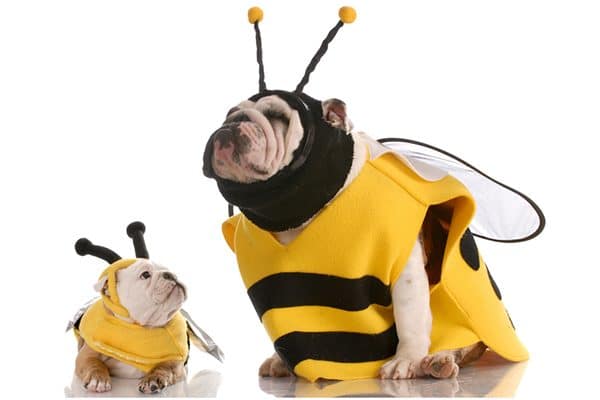Do you know what to do about a dog bee sting? Find out what happens, what is normal and when you need to seek veterinary attention.

Dogs dressed as bees are cute – but dogs stung by bees sure aren’t! Photography by John Mcallister/Thinkstock.
Some swelling is normal.
With bee stings, dogs typically have some swelling at the site of the sting, but it’s rarely life threatening.
True allergic reactions are not common, but they can be life threatening.
If you know your dog was stung by a bee, keep a close eye on him for a few hours. “Facial swelling, hives and generalized itching would be considered an emergency,” says Jamie Mays, DVM, the medical director of VCA Pets First in Richmond, Virginia. “If a dog has a history of life-threatening reactions, we can prescribe EpiPens so owners have some at-home emergency care they can do.”
Dogs are most commonly stung by bees on the face or feet.
Dogs are frequently stung when they step on a bee or when they sniff at a bee to investigate. Pups who are unfamiliar with bees (and don’t know that they can sting) might even try to bite a bee as it buzzes around. “Occasionally you’ll see dogs that bite at them and they’ll have stings to the inside of their mouth, which can be really uncomfortable and the swelling can potentially interfere with their airways,” Dr. Mays explains. “For those guys, I would probably bring them in sooner rather than later.”
Multiple bee stings cause more problems.
The swelling can be more concerning when dogs get more than one sting. “If they get into a hive and they have lots of stings, especially to the face, the swelling is the thing that’s the most concerning,” Mays says. “We can arrest a lot of the swelling with an antihistamine injection. It kicks in in about 20 minutes, so it’s really fast and effective.”
You might not even realize your dog has been stung by a bee.
If you don’t see the bee and your dog doesn’t yelp, you might not realize he was stung unless you notice swelling. See facial swelling or notice your dog breaking out in hives? Rush your pup to the veterinarian immediately.
Some treatments for a dog bee sting provide quick relief.
Whether your dog is experiencing an allergic reaction, or is just uncomfortable due to swelling at the sting site, your vet can help. “Depending on the level of the reaction, they probably would be administered an injectable antihistamine and possibly a steroid,” Dr. Mays says. “Typically, we have the owner and the dog stay in the hospital for the next 30 minutes to an hour until the reaction starts to reverse and the swelling starts to recede. After that, it’s usually at-home care with Benadryl tablets to keep it under control for a couple of days.”
If you see the stinger still lodged in your dog’s skin, don’t pull it out with tweezers.
This can squeeze more venom into your dog. Scrape the stinger with the edge of a credit card to pop it out instead.
Thumbnail: Photography by kozorog/Thinkstock.
Read more about dog health on Dogster.com:
- What You Need to Know About Dog Flu — Prevention and Treatment
- Don’t Get It Twisted: How to Prevent Bloat in Dogs
- Dog Vomiting: What Canine Parents Need to Know
The post Dealing with a Dog Bee Sting? What to Do appeared first on Dogster.
No comments:
Post a Comment